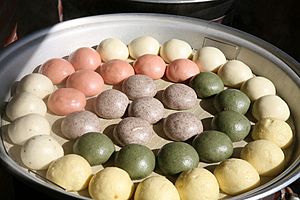Jjinppang facts for kids

Jjinppang of many colors in a steamer
|
|
| Alternative names | Steamed bun |
|---|---|
| Place of origin | Korea |
| Associated national cuisine | Korean cuisine |
| Serving temperature | Hot |
| Main ingredients | Wheat flour, red bean paste |
| Ingredients generally used | Yeast from makgeolli, butter, salt, sugar |
| Variations | Hoppang |
| 177 kcal (741 kJ) | |
| Similar dishes | Liánróngbāo Begodya |
| Korean name | |
| Hangul |
찐빵
|
|---|---|
| Revised Romanization | jjinppang |
| McCune–Reischauer | tchinppang |
| IPA | [t͈ɕin.p͈aŋ] |
Jjinppang (which means "steamed bread" in Korean) is a yummy steamed bun from Korea. It's usually filled with a sweet red bean paste. This paste often has small pieces of beans and their skins in it.
Traditional jjinppang is made using a special kind of dough called sourdough. This dough gets its lift from yeast found in makgeolli, which is a Korean rice wine. But some newer types, like hoppang, are made without this special fermentation process.
When jjinppang is warm, it's very soft. This is because it has a lot of water in it. But as it cools down, it gets harder. So, it's best to eat jjinppang while it's still hot and fresh! If your jjinppang gets hard, you can steam it again to make it soft and warm before you eat it.
Where Jjinppang Comes From
Jjinppang is a very special food from a place called Anheung Township. This township is in Hoengseong County, which is part of Gangwon Province in South Korea.
In Anheung Township, there's a whole area known as Anheung Jjinppang Village. About 17 different shops there make a famous type of jjinppang called Anheung-jjinppang. Since 1999, the township has even held an Anheung Jjinppang Festival every October. It's a fun way to celebrate this delicious bun!
Different Kinds of Jjinppang
There are a few different kinds of jjinppang you might find:
- Anheung-jjinppang – This is the traditional kind of jjinppang. It's made using sourdough that gets its yeast from makgeolli (rice wine). It's a special food from Anheung.
- Gamgyul-jjinppang – This is a mandarin orange jjinppang. You can find it on Jeju Island. The dough for this bun is orange because it's made with mandarin oranges.
- Hoppang – This is another type of jjinppang. It's usually filled with a red bean paste that is sweeter and smoother. The bean skins are removed from the paste to make it extra smooth.
Gallery


